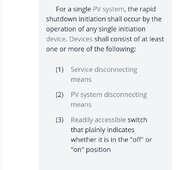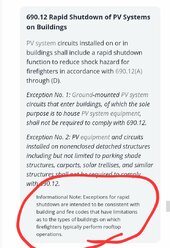ElkPicture
New Member
Hello,
I plan on having a ground array in my yard and next to the ground array frame I'll have a combiner box just in case I want to add another array in the future. From my combiner box I'll be running properly sized THHN underground at least 18 inches deep in schedule 40 pvc conduit. From there I'll run schedule 80 conduit vertically up the side of my brick house. I'll have a junction box at the top of this vertical conduit, right before the wires goes into my house soffit and attic. From the outside PVC junction box I'll run flexible metal conduit up, into my attic and then across my attic to right above my electrical panel and 6000xp. I plan on running the flexible metal conduit down INSIDE of the wall and pop it out inside a wire trough that will be located right below by 6000xp. Getting the flexible metal conduit in the wall might be the tough part but I think I'll like having it hidden in the wall.
I thought I heard somewhere that I need high voltage DC PV wires in metal conduit when they are inside my home... so that's currently what I'm planning on doing. I plan on running THHN the whole way...I've already purchased it.
2 Questions,
1) Do you have any recommendation changes on the wiring as explained above? I can't really think of a better way to do it. THHN wire already purchased.
2) Do you know where in the NEC 2023 or 2020 code book it mentions high voltage PV wire needs to be in metal conduit when inside a structure? I've search the code book and I can't find that section.
Thanks.
I plan on having a ground array in my yard and next to the ground array frame I'll have a combiner box just in case I want to add another array in the future. From my combiner box I'll be running properly sized THHN underground at least 18 inches deep in schedule 40 pvc conduit. From there I'll run schedule 80 conduit vertically up the side of my brick house. I'll have a junction box at the top of this vertical conduit, right before the wires goes into my house soffit and attic. From the outside PVC junction box I'll run flexible metal conduit up, into my attic and then across my attic to right above my electrical panel and 6000xp. I plan on running the flexible metal conduit down INSIDE of the wall and pop it out inside a wire trough that will be located right below by 6000xp. Getting the flexible metal conduit in the wall might be the tough part but I think I'll like having it hidden in the wall.
I thought I heard somewhere that I need high voltage DC PV wires in metal conduit when they are inside my home... so that's currently what I'm planning on doing. I plan on running THHN the whole way...I've already purchased it.
2 Questions,
1) Do you have any recommendation changes on the wiring as explained above? I can't really think of a better way to do it. THHN wire already purchased.
2) Do you know where in the NEC 2023 or 2020 code book it mentions high voltage PV wire needs to be in metal conduit when inside a structure? I've search the code book and I can't find that section.
Thanks.
Last edited:





